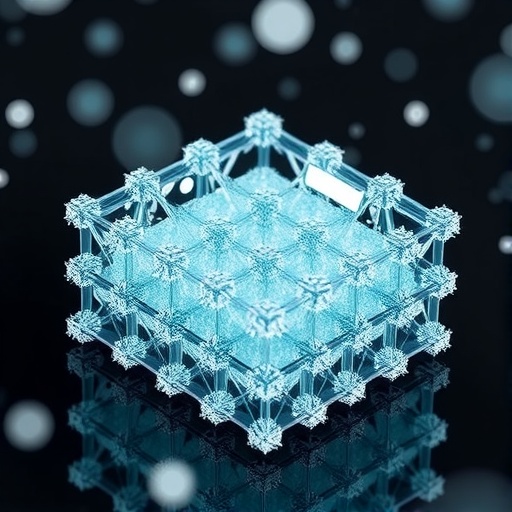Researchers have been making strides in the field of energy storage, focusing on materials that enhance the performance of supercapacitors – devices that are crucial for modern electronics and renewable energy systems. A recent study by Preethi et al., published in Ionics, investigates the role of crystallinity and conductivity within Pr₁₋ₓNiₓO perovskites, a class of materials that has shown promise for such applications. The innovative approach taken in this research highlights new paths for developing more efficient energy storage solutions.
Supercapacitors are revered for their ability to deliver quick bursts of energy and their extended lifecycle compared to conventional batteries. The researchers of this study aim to develop supercapacitors with improved performance metrics. Specifically, they investigate how adjusting the crystallinity and conductivity of Pr₁₋ₓNiₓO can result in superior charge-discharge characteristics, which are vital for achieving practical energy storage devices.
The study begins by discussing the inherent properties of perovskite materials, particularly the composition Pr₁₋ₓNiₓO, where varying the ratio of praseodymium to nickel can lead to significant changes in the material’s characteristics. The researchers emphasize that tuning the composition of these materials affects both the internal structure and electronic interactions within the material. This is essential, as the structural properties directly influence energy storage capabilities and overall performance.
Characterizing crystallinity within these materials is a critical step in understanding their behavior. The researchers employ advanced analytical techniques, including X-ray diffraction and electron microscopy, to reveal insights into how crystallinity impacts the functional attributes of Pr₁₋ₓNiₓO. The findings suggest that higher degrees of crystallinity correlate with enhanced electrical conductivity, allowing for improved ion transport during charge-discharge cycles.
One of the most exciting facets of this research is the synergistic effect observed between crystallinity and conductivity. The adjustments made to the niobium-doping levels have shown a reciprocal relationship that optimizes both properties simultaneously. This resulted in the emergence of a new class of materials that can effectively manage the energy storage processes crucial for supercapacitor functionality.
Mixed ionic and electronic conductivity is another focus of the study, as it bridges the gap between electrical conductivity and ionic diffusion. This dual capability is essential for supercapacitors that require both efficient electronic pathways and ionic migration to function effectively. The combination of these features in the Pr₁₋ₓNiₓO perovskites suggests they may significantly outperform existing materials currently utilized in supercapacitors.
The investigation incorporates a variety of synthesis methods to create these perovskite materials. The researchers explore sol-gel processes, solid-state reactions, and other advanced techniques to achieve tailored compositions and structures. Each method offers distinct advantages in terms of scalability and reproducibility, presenting a pathway to manufacturing supercapacitors using Pr₁₋ₓNiₓO with consistent performance.
Results from the electrochemical tests conducted on the synthesized materials indicate that the charge-discharge cycles yield excellent capacitance values and remarkable cycle stability. This research makes a compelling case for incorporating Pr₁₋ₓNiₓO perovskites in the next generation of supercapacitors, especially in applications where rapid energy release is necessary, such as in electric vehicles and portable electronic devices.
The scalability of the methods and the potential for integration into existing manufacturing processes are paramount. The findings suggest not just theoretical improvements, but actionable insights into how supercapacitor technology could evolve in both performance and manufacturing efficiency. Researchers are optimistic about how these advancements could be translated into commercial products that meet the growing demands for energy storage in modern society.
This work highlights the continuing importance of material science in addressing the global energy challenge. As the demand for renewable energy grows, so too does the need for efficient energy storage solutions. The innovative enhancements provided by Pr₁₋ₓNiₓO perovskites could well play a significant role in ushering in a new era of energy technologies.
Furthermore, the interdisciplinary nature of this research showcases how chemistry, materials science, and electrical engineering can come together to solve complex problems. This approach not only broadens the horizons for supercapacitor design but also paves the way for novel applications that leverage these advanced materials.
As researchers look ahead, the path forward will likely involve further characterizing the long-term stability and performance of these materials in real-world conditions. Continued exploration into the mechanisms governing their properties will be essential in establishing their viability in commercial markets. In light of this research, there is a growing optimism that the landscape of energy storage is on the cusp of transformative changes.
In conclusion, the study conducted by Preethi et al. represents a significant step toward optimizing supercapacitor technology through tailored perovskite materials. By enhancing both crystallinity and conductivity in Pr₁₋ₓNiₓO perovskites, the researchers contribute to the development of next-generation energy storage solutions that can meet the increasingly demanding requirements of modern technology. This work exemplifies how collaborative research can propel advancements in critical fields, driving toward a more sustainable energy future.
Subject of Research: Supercapacitor applications of Pr₁₋ₓNiₓO perovskites.
Article Title: Tailoring crystallinity and conductivity in Pr₁₋ₓNiₓO perovskites for supercapacitor applications.
Article References:
Preethi, A.C., Hariharakrishnan, V. & Saraswathi, V. Tailoring crystallinity and conductivity in Pr₁₋ₓNiₓO perovskites for supercapacitor applications. Ionics (2025). https://doi.org/10.1007/s11581-025-06529-1
Image Credits: AI Generated
DOI: https://doi.org/10.1007/s11581-025-06529-1
Keywords: Supercapacitors, Pr₁₋ₓNiₓO perovskites, crystallinity, conductivity, energy storage, material science.




